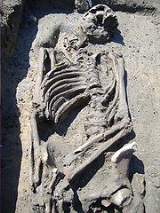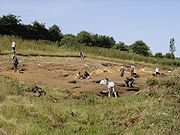
Sedgeford Historical and Archaeological Research Project
Encyclopedia
The Sedgeford Historical and Archaeological Research Project (SHARP) is a long-term, multidisciplinary research project based in north-west Norfolk
, UK. It is involved in the investigation of the local history and archaeology
, with a strong emphasis on community involvement, practical training and education. The Project attracts volunteer excavators and students from all over the world.
 In 1957-58, Peter Jewell of the University of Cambridge
In 1957-58, Peter Jewell of the University of Cambridge
excavated small trenches on the "Boneyard Field" and recorded a number of human burials and features.
SHARP was founded in 1996, initially focussing on the same Anglo-Saxon
cemetery located to the south of the modern village of Sedgeford
. Since that time, SHARP has investigated many other sites within the parish
using a variety of methods: open-area excavation, test-pitting, geophysical survey
, fieldwalking
and metal detection, and the analysis of historical documents.
, and Anglo-Saxon history. However, unlike most training sites, it is independent from any one academic institution and operates as a registered UK charity (number 1064553).
 Over the years a number of particularly unusual discoveries have been made:
Over the years a number of particularly unusual discoveries have been made:
Norfolk
Norfolk is a low-lying county in the East of England. It has borders with Lincolnshire to the west, Cambridgeshire to the west and southwest and Suffolk to the south. Its northern and eastern boundaries are the North Sea coast and to the north-west the county is bordered by The Wash. The county...
, UK. It is involved in the investigation of the local history and archaeology
Archaeology
Archaeology, or archeology , is the study of human society, primarily through the recovery and analysis of the material culture and environmental data that they have left behind, which includes artifacts, architecture, biofacts and cultural landscapes...
, with a strong emphasis on community involvement, practical training and education. The Project attracts volunteer excavators and students from all over the world.
History

University of Cambridge
The University of Cambridge is a public research university located in Cambridge, United Kingdom. It is the second-oldest university in both the United Kingdom and the English-speaking world , and the seventh-oldest globally...
excavated small trenches on the "Boneyard Field" and recorded a number of human burials and features.
SHARP was founded in 1996, initially focussing on the same Anglo-Saxon
Anglo-Saxons
Anglo-Saxon is a term used by historians to designate the Germanic tribes who invaded and settled the south and east of Great Britain beginning in the early 5th century AD, and the period from their creation of the English nation to the Norman conquest. The Anglo-Saxon Era denotes the period of...
cemetery located to the south of the modern village of Sedgeford
Sedgeford
Sedgeford is a civil parish in the English county of Norfolk, about 6 km south of the North Sea and east of the Wash. It is approximately north east of Cambridge.It covers an area of and had a population of 540 in 224 households as of the 2001 census....
. Since that time, SHARP has investigated many other sites within the parish
Parish
A parish is a territorial unit historically under the pastoral care and clerical jurisdiction of one parish priest, who might be assisted in his pastoral duties by a curate or curates - also priests but not the parish priest - from a more or less central parish church with its associated organization...
using a variety of methods: open-area excavation, test-pitting, geophysical survey
Archaeological geophysics
Geophysical survey in archaeology most often refers to ground-based physical sensing techniques used for archaeological imaging or mapping. Remote sensing and marine surveys are also used in archaeology, but are generally considered separate disciplines...
, fieldwalking
Archaeological field survey
Archaeological field survey is the method by which archaeologists search for archaeological sites and collect information about the location, distribution and organization of past human cultures across a large area...
and metal detection, and the analysis of historical documents.
Organization
SHARP is made up of a team of directors, supervisors, trustees and committee members, along with up to 70 excavators during June-August.Education
The Project is one of the largest training digs in the UK, providing practical training in excavation and recording as well as running taught courses on aspects of the site: e.g. skeletal remains, artefactsArtifact (archaeology)
An artifact or artefact is "something made or given shape by man, such as a tool or a work of art, esp an object of archaeological interest"...
, and Anglo-Saxon history. However, unlike most training sites, it is independent from any one academic institution and operates as a registered UK charity (number 1064553).
Sites and finds of interest

- part of The Sedgeford TorcSedgeford TorcThe Sedgeford Torc is a broken Iron Age gold torc found near the village of Sedgeford in Norfolk. The main part of the torc was found during harrowing of a field in 1965, and the missing terminal was found by Dr. Steve Hammond during fieldwork by the Sedgeford Historical and Archaeological...
- discovered by SHARP in 2004, the missing gold Iron AgeIron AgeThe Iron Age is the archaeological period generally occurring after the Bronze Age, marked by the prevalent use of iron. The early period of the age is characterized by the widespread use of iron or steel. The adoption of such material coincided with other changes in society, including differing...
torcTorcA torc, also spelled torq or torque, is a large, usually rigid, neck ring typically made from strands of metal twisted together. The great majority are open-ended at the front, although many seem designed for near-permanent wear and would have been difficult to remove. Smaller torcs worn around...
terminal of the main body of the Sedgeford torc (found in 1965) has been reunited with the rest of the artefact in the British MuseumBritish MuseumThe British Museum is a museum of human history and culture in London. Its collections, which number more than seven million objects, are amongst the largest and most comprehensive in the world and originate from all continents, illustrating and documenting the story of human culture from its...
. - The Sedgeford Hoard - recovered during the 2003 excavation season. This Iron Age hoard of Gallo-Belgic gold staterStaterThe stater was an ancient coin used in various regions of Greece.-History:The stater is mostly of Macedonian origin. Celtic tribes brought it in to Europe after using it as mercenaries in north Greece. It circulated from the 8th century BC to 50 AD...
s was hidden in a cow bone and identified by x-ray. - Iron Age horse burial - discovered on the same day as the hoard of coins.
- The Body in the Oven - unexpectedly found in 2006 from a Roman site. This human skeleton had been burned in a feature believed to be a fire-pit for a grain-dryer or malting oven. Several unusual aspects of the find led to it being described as "an unsolved murder" in the local and national press. There are few equivalent cremationCremationCremation is the process of reducing bodies to basic chemical compounds such as gasses and bone fragments. This is accomplished through high-temperature burning, vaporization and oxidation....
/inhumations from this period anywhere in Europe. - Boneyard - the whole site, excavated from 1996–2007, revealed part of an extensive cemetery. Almost 300 articulated human inhumations were lifted, reflecting only a portion of the actual number buried. In addition SHARP recovered a huge quantity of disarticulated human bone (charnel). The size of this burial site, particularly as there is no large population centre known nearby, makes it a very unusual skeletal archive.

